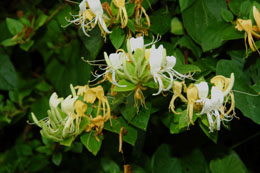The twining honeysuckle vines are easy to grow and produce fragrant, trumpet-shaped flowers. This write-up provides information on the popular varieties of this vine and tips for caring for this plant.

Categorized under the
Lonicera genus and
Caprifoliaceae family, there are about 180 species of honeysuckle shrubs and vines. These are native to China, Europe, and North America. They bloom profusely during the spring and summer season. This vine can be grown along a rock wall or a lattice trellis. Its dense growth can block the sunlight and provide shade, whereas the sweet fragrance of this beautiful vine will surely attract a lot of bees, hummingbirds, and butterflies. This flowering vine produces trumpet-shaped flowers. The flowers come in several colors such as pink, purple, red, white, or yellow. The leaves of this vine are oval. It also produces a fruit. In several varieties, the fruit is slightly poisonous, so make sure that you grow a vine that doesn't produce poisonous berries.
Varieties
These vines are easy to grow. Some of the vines are evergreen and some are deciduous. One of the common varieties is the trumpet honeysuckle or
Lonicera sempervirens. This variety can be found in eastern United States. The tubular blooms look very beautiful. These scarlet flowers have yellow interiors. Their stems are 10-12 feet long. These can be used to beautify the trellises or fences; however, the flowers are not fragrant.
Other varieties include Goldflame, Dropmore scarlet, and Japanese honeysuckle. The common variety produces white and pink blossoms in the summer season. The vine can grow to a height of 25 feet. Dropmore scarlet variety produces beautiful crimson flowers and the vine can reach a height of about 12 feet. Goldflame vine produces bright yellow flowers and can reach a height of 15 feet.
How to Grow this Vine
First of all, choose a location where the vine can receive at least 4 hours of sunshine daily. It is advisable to plant this vine in the early spring. Use a fertilizer or manure to replenish the soil. This plant grows well in acidic soil. You could test the soil's pH to ensure that it is in the range of 5.5-7. While planting the vines, keep a distance of at least three feet between them. This is done to ensure that the vines have enough space to spread. To allow these vines to climb, place a trellis directly behind the vine.
As far as watering is concerned, make sure that the soil is moist during the growing season. Don't let the soil become dry. When the new growth appears, the plant should be mulched with a thick layer of leaves. Mulching is required to preserve the moisture during the summer. During the winter, mulching with leaves will protect the roots of the plant.
Since honeysuckle plants are hardy in nature, you could prune them lightly during the flowering season. You must restrict yourself to light pruning in the first two years of its growth. Thereafter, you could proceed with heavy pruning when the plant is in the dormant stage. Untangle the vines and get rid of the dead wood and old growth. Since the vines follow an aggressive growth pattern, these can encroach on other plants and hamper their growth. So, prune them to protect other plants. Another important aspect is the protection of this vine from diseases. Along with bees, its sweet nectar also attracts insects such as aphids and moths, which can cause a lot of damage. Spray insecticides if you see signs of powdery mildew.
While the sweet-scented flowers of this vine will fill the ambiance with sweet fragrance, you will also get to see bees and hummingbirds hovering over these funnel-shaped flowers. Do follow the aforementioned instructions to keep this vine in a good condition.






 Categorized under the Lonicera genus and Caprifoliaceae family, there are about 180 species of honeysuckle shrubs and vines. These are native to China, Europe, and North America. They bloom profusely during the spring and summer season. This vine can be grown along a rock wall or a lattice trellis. Its dense growth can block the sunlight and provide shade, whereas the sweet fragrance of this beautiful vine will surely attract a lot of bees, hummingbirds, and butterflies. This flowering vine produces trumpet-shaped flowers. The flowers come in several colors such as pink, purple, red, white, or yellow. The leaves of this vine are oval. It also produces a fruit. In several varieties, the fruit is slightly poisonous, so make sure that you grow a vine that doesn't produce poisonous berries.
Categorized under the Lonicera genus and Caprifoliaceae family, there are about 180 species of honeysuckle shrubs and vines. These are native to China, Europe, and North America. They bloom profusely during the spring and summer season. This vine can be grown along a rock wall or a lattice trellis. Its dense growth can block the sunlight and provide shade, whereas the sweet fragrance of this beautiful vine will surely attract a lot of bees, hummingbirds, and butterflies. This flowering vine produces trumpet-shaped flowers. The flowers come in several colors such as pink, purple, red, white, or yellow. The leaves of this vine are oval. It also produces a fruit. In several varieties, the fruit is slightly poisonous, so make sure that you grow a vine that doesn't produce poisonous berries.